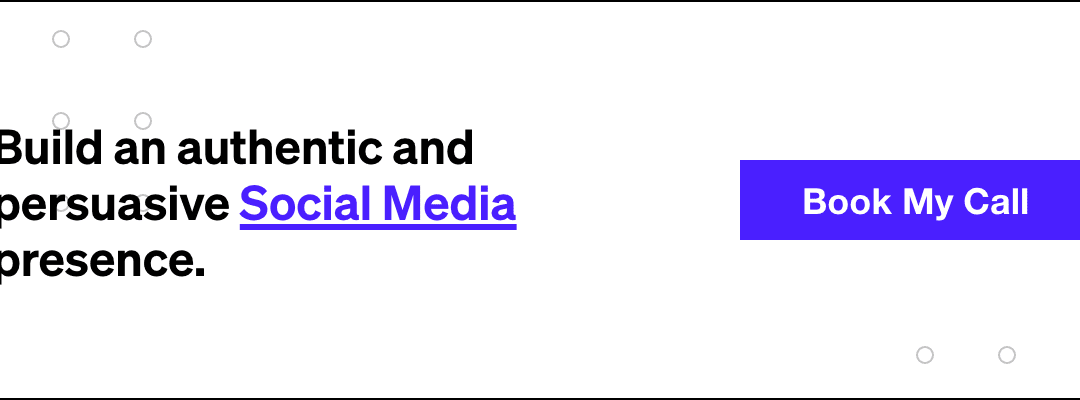If you’re like most companies, your marketing strategy has probably taken a wide approach—establish a presence on as many social platforms as your team has the bandwidth to manage and post like the wind.
While this technique may boost your probability of reaching the most users possible, casting a wide net over online provinces—from Facebook to TikTok—is most effective when you have a social media strategy behind it.
Enter the social media audit.
Social media audits investigate your brand’s messaging to glean measurable, key pieces of data about your marketing performance—where you’re succeeding and where you could tighten the bolts. These audits can be enormously complex, but their logic is simple: if you know what’s resonating with your target audience, your creative team can replicate it.
Let’s dive into what a social media audit entails.
What Do Social Media Audits Accomplish?
Whether you’re popping champagne because your last video went viral or wondering why your artfully crafted posts aren’t garnering likes, every company has something to gain from tactfully conducted social media auditing.
The list of data points social media audits can index is long and nuanced. However, some of the most telling information includes:
- Which demographics are engaging with your content
- How users engage with your content
- When users engage with your content
- The reach of your post
- What makes users stop
- What keeps them scrolling
- The rate at which your following is growing
- Where the traffic to your profiles is coming from
Aside from offering immensely valuable information, they also work on another layer: helping you identify your brand’s core goals and values. The clearer you are on your core tenets, the better you’ll understand where your identity and your target audience’s align (bullseye!).
Why Perform A Social Media Audit?
Maintenance and analysis are paramount for any successful social media marketing campaign, no matter what authority it holds. Given the complexity and variables that come with the social channel, running a social media audit can benefit your brand in several ways:
- It’s a money-saver – If the forecasts are right, digital marketing spending will pass $200 billion within the next 3 years in the US alone.1 No matter how much you’ve allocated to your marketing budget, social media audits can teach you which initiatives are working—and why—so that you can maximize your social media ROI.
- It bolsters content quality – Many companies ask themselves whether it’s better to have a lukewarm social media presence or to stay out of the fray altogether.2 While how you position yourself online depends on your brand identity, a well-run social media audit should yield results that mean you won’t have to choose.
- It’s a relationship-builder – Think of social media audits as a two-way mirror: not only do they provide information on your creative output, but they can also offer key information about who your customers are and what resonates with them. Remember, marketing is a two-way street. The better you know your consumer, the easier it will be to foster long-term relationships with them.
- It improves your company culture – Social media auditing isn’t just for optimizing your relationship with the public. When executed with care and tenacity, they can also enhance the relationships between your stakeholders—particularly those on your creative team. Having a data-backed social media marketing strategy is critical for working smarter and refining your output. As a result, you’ll extract the most out of your marketing budget and the creative engine behind your enterprise.
Running the numbers on your social media content can benefit nearly every element of your business, earning you significant returns in the long term.
But here’s the kicker: no two marketing companies will conduct a social media audit the same way.
Truly effective social media audits deliver and then interpret data. Whether you opt to conduct your own or partner with a company with an internet marketing service versed in the science (and art) of social media audits, the most important result is actionable suggestions that can improve your:
- Campaign performance
- Brand identity
- Customer relationships
- Creative team’s visibility
How To Conduct A Results-Driven Social Media Audit, Step By Step
Comprehensive social media audits are typically drafted by talented marketing agencies with technological and creative resources to foster and then articulate data. However, if you’re not ready to find a partner just yet, there are some best practices to keep in mind when generating an audit internally.
Typically, social media audits start at the foundation. It’s a bottom-up approach.
Before you begin, you need to know:
- What you’re testing (e.g. Instagram posts, TikTok videos, or TikTok videos reposted to Instagram)
- Why you’re testing it (e.g. Why did this image rake in 4k likes, while another only inspired a few hundred?)
- What do you hope to learn from conducting our audit (e.g. What copy makes YouTube viewers more inclined to subscribe?)
Every brand is different, and every marketing company takes a singular approach to its creative testing methodology.
Nevertheless, the underlying logic is ubiquitous—each successful piece of social media content drives conversions for an explicit reason.
Through social media audits, you uncover the driving force behind these successes.
Step 1: Identify Your Content Type
From blog posts to podcasts, each content creation can be broken down into a series of elements, and each social media platform can offer valuable information about which “element” finds its footing and which slips away.
Let’s say a supplement brand in the wellness sector wants to examine its short-form video content. Typically, every video can be divided into four parts:
- The hook – What is hook rate success? Video thumbnails or hooks are what make a user stop scrolling and start watching. The hook generally lasts about 3 seconds~.
- The callout – The callout or “meat” constitutes the video’s main purpose. The meat of a video may inform, persuade, or entertain a user so they stay engaged.
- Social proof – Social proof tempts users to follow you further after the video elapses. Ideally, proof makes people want to learn more about you, your product, or your service, but not every video requires social proof to get your message across.
- The CTA – CTAs, “end cards,” or LPs are the final moments of a video that encourage a conversation. Whether that’s making a purchase or clicking subscribe, every video should make your viewer’s next step crystal clear.
Facebook, for instance, offers companies a tremendous amount of data about video ads such as Facebook video ad metrics and Facebook video impressions through their platform. Using Facebook’s data, the supplement brand can learn information such as:
- Average viewing time for a single or multiple videos
- Which element of a video saw engagement lapse
- What percentage of viewers stuck around until the end
- Which elements made them click through to the next link
Remember, content marketing spans multiple media formats, and each format has its own unique grammar. Social media audits should identify your top 3 KPIs (key performance indicators) for each individual medium to learn which creative approaches complement each type of asset.
Step 2: Keep Your Data Organized
If you’re conducting your company’s social media audit on your own, be sure to track down an organizational tool that can help you segment and qualify your findings.
A social media audit tool that is organizational is critical for keeping track of a prodigious amount of information. They’ll also serve you well in future audits so that you can compare your performance over time.
To start creating your information trove, your best bet is to recruit a visual organizing tool that can help you map the data you’re working with.
To that end, embrace the template craze.
If this is your first time performing an audit, there are myriad free or low-cost online organizers you can use to collect your data, many of which make it easy to collaborate with your colleagues. Keeping all of your information shareable and easy to retrieve will make it that much easier when it’s time to use the data for optimization.
Step 3: Get To Know The Competition
The social media ecosystem can be competitive, but you can learn as much from your peers as you can from your social media audit. While you won’t be able to sneak a peek at your competitor’s data, you can gauge their performance from social media engagement.
It may be worth your while to review:
- User comments, especially ones that express specific grievances or acclaim for a given brand
- User reviews, including questions users still have about products, services, or brand identity
- Brand value props, especially the ones associated with their most successful posts or content
If the infinite scroll teaches us anything, it’s that there’s more than enough room online for brands to thrive.
Know thyself, know thy competition, and the easier it will be to build your unique identity and reach the consumers that are desperately waiting to meet you.
Make the Most Of Your Social Audit with Power Digital
Social media audits are your brand’s map, your compass, and your guide: they establish where you are, which direction you’re headed, and the kind of path you can pave to expedite your journey to success.
From dissecting content composition to helping craft a magnetic rebranding initiative, Power Digital’s digital marketing agency has the resources to fine-tune each dimension of your online presence.
For a social media audit that goes beyond data compilation and brand analysis, choose social media management that can weld insights into creative solutions. To start your brand’s holistic social media audit, reach out to us today.
Sources:
- Statista. Digital advertising in North America – statistics & facts. https://www.statista.com/topics/5995/digital-advertising-in-north-america/#topicHeader__wrapper
- The Guardian. Is a bad social media presence better than none at all? https://www.theguardian.com/voluntary-sector-network/2012/jul/24/bad-social-media-better-than-none
The post Social Media Audit: What Are They and Why Does Your Business Need One? appeared first on Power Digital Marketing.
Article From: "Power Digital" Read full article
 SERPCOM is a full-service Boston digital marketing agency focused on improving online visibility, increasing traffic, raising revenue and providing SEO services.
SERPCOM is a full-service Boston digital marketing agency focused on improving online visibility, increasing traffic, raising revenue and providing SEO services.
SEO-first: A fundamentally better approach to online marketing.
Digital Marketing | SEO | Web Design & Development | Search Engine Marketing

SERPCOM is a full-service Boston digital marketing agency focused on improving online visibility, increasing traffic, raising revenue and providing SEO services. SEO-first: A fundamentally better approach to online marketing.
Digital Marketing | SEO | Web Design & Development | Search Engine Marketing
SERPCOM is a full-service Boston marketing agency focused on improving online visibility, increasing traffic, raising revenue and providing SEO services for leading brands.
Maximize the value of your website and turbo charge your online marketing efforts with SERPCOM. Call or click the button and start making the web work for you.
Just click on the Phone Number to dial on your phone:





